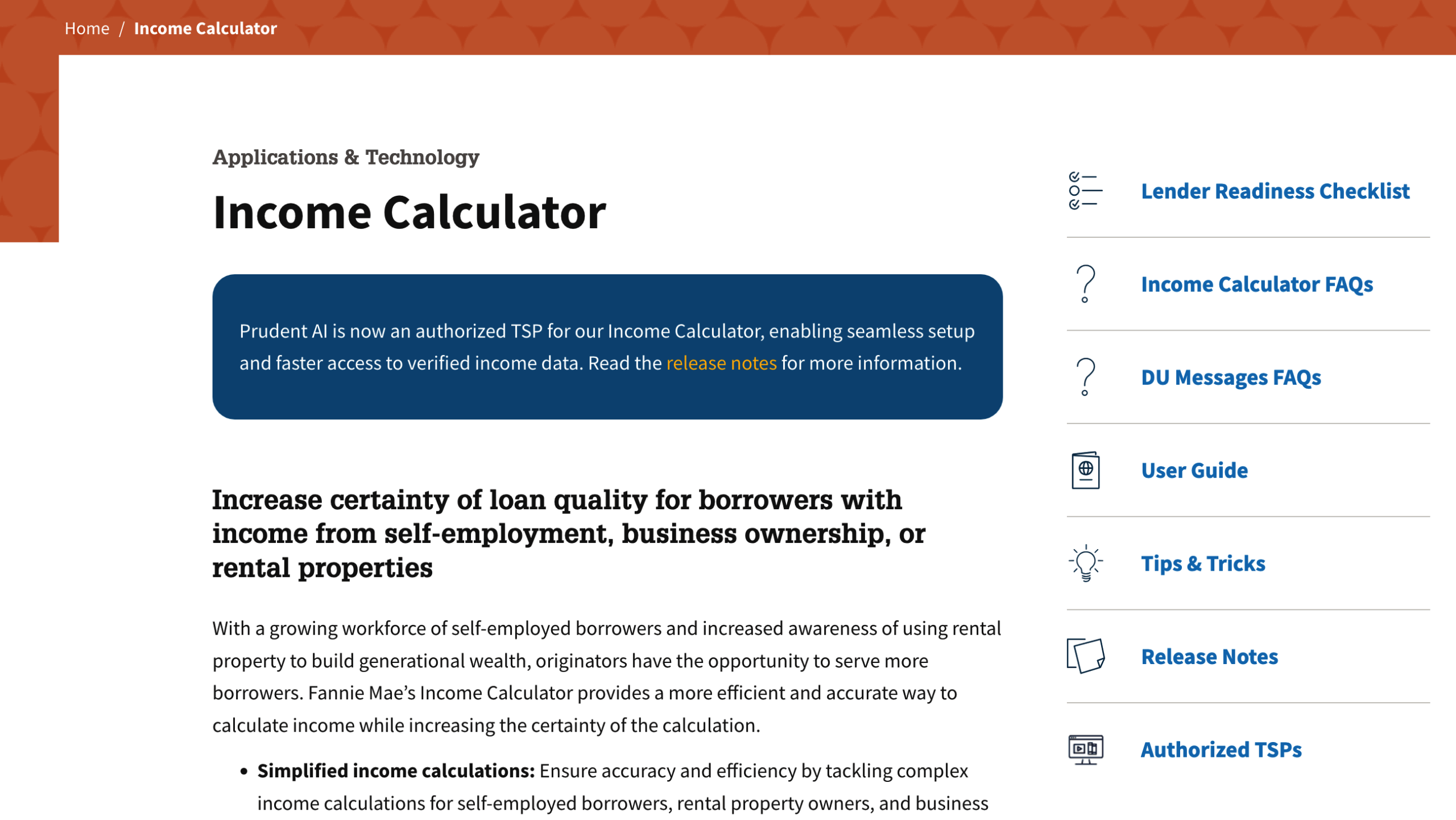Rapidio · Mortgage Income Best Practices
Fannie Mae Income Calculator: W‑2 & Self‑Employed to Guideline (2025)
A practical, guideline‑aligned walkthrough for underwriters, loan officers, and mortgage brokers. Learn how to calculate qualifying income for W‑2, variable pay, and self‑employed borrowers (plus Schedule E rental), with clear examples you can use today.
- Audience: Underwriters, Loan Officers, Mortgage Analysts, Brokers
- Updated:
- Topics: Fannie Mae income calculator · W‑2 · self‑employed · Schedule C · Schedule E · 1003 form · AUS (DU) vs. manual underwriting · AI mortgage underwriting
What this guide covers
Use this Fannie Mae income calculator guide to convert real documents into qualifying income that aligns with the 2025 Selling Guide. It’s written for pros — underwriters, loan officers, mortgage brokers, and mortgage analysts — who need a fast, defensible approach to income analysis. We’ll cover W‑2 wages, Fannie Mae self‑employed analysis (Form 1084 style), Schedule E rental income, and how to think about variable income (overtime/bonus/commission). We also touch on AUS mortgage (Desktop Underwriter) vs. manual underwriting, and documentation you’ll pull from the 1003 form.
W‑2 income: base, hourly, salary
For W‑2 borrowers, start by confirming stability and likelihood of continuance. Then normalize pay to a monthly figure:
- Salary: Annual ÷ 12.
- Hourly: Hourly × hrs/week × 52 ÷ 12 (confirm standard hours and any unpaid breaks).
- Weekly/Biweekly: Weekly × 52 ÷ 12; Biweekly × 26 ÷ 12.
Validate using recent paystubs, W‑2s, and written/verbal VOE as appropriate. When pay patterns changed recently (e.g., job change, shift change), document the effective date and rationale.
Variable income: overtime, bonus, commission
Variable components require a sufficient history—commonly 24 months — and a trend analysis. Typical steps:
- Collect YTD paystub detail + prior‑year W‑2 (and, if needed, the year before).
- Compute a 24‑month average for overtime/bonus/commission.
- Assess the trend. If declining, consider using a more conservative average and document the reasonability.
- Confirm the employer indicates the income is likely to continue.
Related searches you may encounter: FHA variable income, how to calculate income, and prequal vs preapproval. While this guide focuses on conventional, the principles of stability and continuity apply across products.
Self‑employed income (Form 1084 approach)
For proprietors’ income calculation (sole props, partnerships, S‑corps), analyze business cash flow using tax returns and a Form 1084‑style worksheet. At a high level:
- Gather applicable returns: Schedule C, Schedule E (K‑1), 1120S/1065 with K‑1s, and business returns. If applicable, include the borrower’s W‑2 from the entity.
- Start with net profit (or pass‑through income) and apply adjustments per guideline (e.g., non‑cash expenses like depreciation/amortization; remove non‑recurring gains/losses; consider required debt service).
- Average over 24 months unless a strong 12‑month case is allowed and documented.
- Assess stability, trend, and any industry impacts. Substantial declines may require additional support or a more conservative approach.
Support docs often include IRS transcripts (4506‑C), bank statements (to corroborate cash flow — note Fannie Mae generally does not use bank statements as the primary income method), and business liquidity analysis for distributions vs. compensation.
Rental income (Schedule E & rents)
For existing rentals, start with Schedule E. For a new rental or departing residence, use the lease/market rent and apply a vacancy factor (often 25%) to estimate net rent, then subtract PITIA to determine the amount added to income (or the shortfall added to liabilities). Keep documentation tight and consistent with the current Selling Guide.
1003 & documentation checklist
Use the 1003 loan application to map employment and income sources, then collect supporting docs. A quick list:
- W‑2s, paystubs, VOE (written/verbal), SSA‑1099 form if applicable
- Tax returns: Schedule C tax form, IRS Schedule E, K‑1s, 1065/1120S/1120
- Transcripts (4506‑C), business returns, entity docs
- Leases/appraisals as needed (related terms people search: “FHA appraisal form 1004” and “1003 loan application PDF”)
DU (AUS) vs. manual underwriting
AUS mortgage findings via Desktop Underwriter (DU) drive most conventional decisions. If you proceed with manual underwriting, document the compensating factors thoroughly and ensure overlays are met. Many teams now augment file reviews with AI mortgage underwriting or an AI loan processor to surface missing docs and guideline conflicts early — reducing redraws and speeding clear‑to‑close.
Worked examples (quick math you can reuse)
1) Salary (W‑2)
Scenario: Borrower earns $72,000/year, stable employment.
Monthly qualifying income: $72,000 ÷ 12 = $6,000.00
2) Hourly + Overtime (W‑2)
Base: $28/hour × 40 hrs/week × 52 ÷ 12 = $58,240 ÷ 12 = $4,853.33/mo
Overtime average (24 months): ($9,600 (PY) + $7,800 (YTD annualized)) ÷ 24 = $17,400 ÷ 24 = $725.00/mo
Total qualifying income: $4,853.33 + $725.00 = $5,578.33/mo (confirm trend and continuance)
3) Self‑Employed (Schedule C + adjustments)
2024: Net profit $84,000; + depreciation $5,000; − non‑recurring gain $2,000 ⇒ Adjusted = $87,000
2023: Net profit $62,000; + depreciation $2,000 ⇒ Adjusted = $64,000
24‑month average (monthly): ($87,000 + $64,000) ÷ 24 = $151,000 ÷ 24 = $6,291.67/mo (assess trend/stability)
4) Rental Income (new lease)
Lease: $2,500/mo. Apply 25% vacancy factor ⇒ $2,500 × 0.75 = $1,875. Subtract PITIA $1,600 ⇒ Net $275/mo added to income (if positive; shortfalls count against liabilities).
Pro tip: Use a standardized worksheet (Form 1084‑style for self‑employed) and keep your 1003 and DU in sync to avoid post‑UW conditions.
Get accurate income in minutes
Upload docs, get guideline‑aligned income with an audit trail, and keep files moving. Perfect for prequal, disclosures, and underwriting.
Start free — 1 reportIncludes W‑2, self‑employed (Form 1084‑style), Schedule E rental, and smart conditions. Human‑in‑the‑loop QC built in.
FAQ: Fannie Mae Income Calculator (2025)
Does Fannie Mae allow a 12‑month average for variable income?
Sometimes, when the history and trends support it. Many files use a 24‑month average for overtime/bonus/commission, with additional documentation if income is declining. Always verify with the current Selling Guide and overlays.
Can I use bank statements as primary income for Fannie Mae?
Fannie Mae generally does not accept bank statements as the primary income method. Use bank statements to corroborate cash flow for self‑employed analysis. Bank statement programs are typically Non‑QM products.
How do I factor rental income from a new lease?
Start with market/lease rent, apply a vacancy factor (often 25%), then subtract PITIA for the subject property. The result can be added to income (positive) or counted as a liability (negative), subject to guideline.
What documents do I need from the borrower?
For W‑2: recent paystubs, W‑2s, VOE. For self‑employed: personal and business tax returns (e.g., Schedule C, Schedule E/K‑1, 1120S/1065), transcripts, and business liquidity as needed. Retirees may provide SSA‑1099. Always align with the 1003 and DU findings.
Is this the same as VA or FHA rules?
No. VA and FHA have their own handbooks and forms (people often search “VA loan” or “FHA appraisal form 1004”). This article focuses on conventional loans sold to Fannie Mae.



